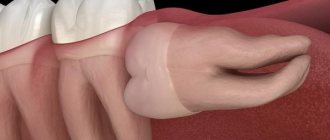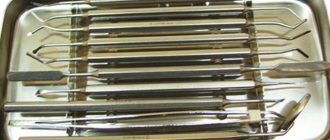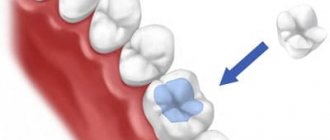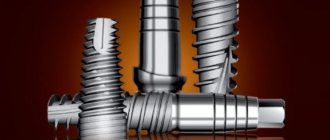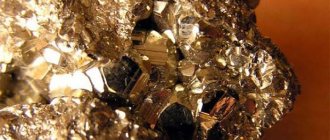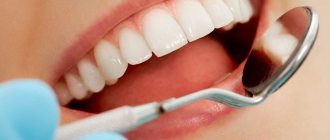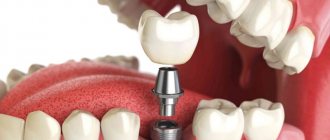Dental stainless steel alloy - dental steel
Steel is the most common alloy in the world.
Its properties are well known. And due to alloying agents, it can be given any desired properties. Dental steel is very cheap.
Among the disadvantages: steel is heavy (density about 8 g/cm3) and chemically active. May cause allergies, galvanosis.
Stainless steel in orthopedic dentistry - grades:
STEEL GRADE 1X18H9T (EYA-1)
Dental alloy for crowns COMPOSITION :
1.1% carbon; 9% nickel;18% chromium; 2% manganese, 0.35% titanium, 1.0% silicon, the rest is iron.
Used for fixed prostheses: individual crowns, cast teeth, facets.
STEEL GRADE 20Х18Н9Т
COMPOSITION: 0.20% carbon, 9% nickel, 18% chromium, 2.0% manganese, 1.0% titanium, 1.0% silicon, the rest is iron.
The following are produced from this type of steel in the factory:
· standard sleeves used for the production of stamped crowns;
· clasp blanks (for ChSPP)
· elastic metal matrices for filling, as well as separation strips
· STEEL for dentistry GRADE 25Х18Н102С
COMPOSITION: 0.25% carbon, 10.0% nickel, 18.0% chromium, 2.0% manganese, 1.8% silicon, the rest is iron.
APPLICATION: manufactured in the factory:
· teeth (lateral upper and lower) for stamped-soldered bridges;
· frames for metal-plastic bridges, for cladding;
· orthodontic wire with a diameter from 0.6 to 2.0 mm (step 0.2 mm)
Silver solder is used as solder for non-precious alloys
Contains silver - 37%, copper - 50%, Manganese - 8-9%, Zinc - 5-6%
Source
Alloys in orthopedic dentistry
Metal occupies a central place among materials in dentistry. Most fixed dentures and removable denture frames are cast (or stamped) from dental alloys. Alloys in dentistry are used as auxiliary materials for soldering and stamping. Dental instruments are made from them.
- Classification of metals and alloys in dentistry
- Structural metal alloys in orthopedic dentistry
- Noble metal alloys in dentistry
- Base alloys in orthopedic dentistry
- Auxiliary metal alloys in dentistry
Primary requirements
The important properties that metals and alloys in dentistry must have are:
- high biological compatibility;
- resistance to corrosion and tarnishing;
- maintaining constant volume and shape;
- safety, no toxicity;
- inertness in the oral cavity;
- mechanical properties (strength, hardness, rigidity, wear resistance, ductility);
- physical properties (density, malleability, thermal conductivity, melting point);
- aesthetic indicators;
- hygienic properties (ease of cleaning with standard dental care products; in the case of using metal dentures, patients should not feel a metallic taste);
- technological characteristics (ease of preparation and processing, segregation).
This is interesting: Advantages of IVOCAP Vivaden prosthetic technology, metal-ceramic crown
Alloys that are intended for ceramic coating must meet the following criteria:
- connects well with porcelain;
- the temperature when processing the alloy should be higher than the temperature when processing porcelain;
- the thermal expansion value of the alloy should be equal to the CTE of porcelain.
An important aspect is shrinkage, which occurs during the transformation of the liquid state of the metal into a solid state.
If the shrinkage is too high, it makes the fabrication of dental structures difficult. Ease of metal casting is important to every dental technician. The lower the temperature when melting and pouring, the easier it is to work with them.
The characteristics of metals must necessarily meet the requirements associated with their purpose and processing methods.
Metals and alloys in dentistry Classification
All metals and alloys are divided into ferrous and non-ferrous.
Ferrous metals are iron and alloys based on it. Steel and cast iron. Cast iron contains more than 2.14% carbon. Not used in dentistry.
The surface of cast iron is matte and non-shiny. It is difficult to polish.
Steel in dentistry
an iron-based alloy containing less than 2.14% carbon. In addition to iron and carbon, steel also contains other metals. They give the alloy new properties (alloy steel), including making it stainless.
Steel copings for stamping crowns
Alloy steel is an alloy of iron and carbon, with the addition of any other metals. They change the properties of the alloy (melting point, hardness, ductility, malleability, etc.).
Alloy steel
Stainless steel is corrosion resistant steel. Chromium (21%), as well as other metals, are most often used as an anti-corrosion agent.
Non-ferrous metals are, respectively, all other metals.
Metals in orthopedic dentistry are divided into noble and non-noble.
Noble metals (or precious metals) are metals that are resistant to corrosion and chemically inert. The main noble metals are gold, silver, and platinum group metals (platinum, palladium, iridium, osmium, etc.).
Base metals are metals that corrode easily and are not found in nature in their pure form. They are always mined from ores.
Purpose
Several decades ago, dentists made medical structures exclusively from noble metals in their pure form.
Gradually, a trend emerged to use them as various alloys. Closer to the 20th century, orthopedic dental appliances made of base metals , in particular alloys of steel and chromium, were common.
Base metals are very hard, which complicates their processing, but thanks to this feature, prostheses can be made of any length.
Pure gold was no longer used due to its insufficient hardness. Today, gold-palladium, gold-platinum, silver-palladium alloys are in demand because they are more durable, resistant to corrosion and have many other positive characteristics.
Base metal alloys are also popular.
They are excellent for ceramic coatings because the oxide film that appears on the surface promotes a strong bond.
Noble metals in dentistry and alloys
Noble metals in dentistry are expensive. But despite this, they continue to be used due to their excellent biocompatibility. They are not subject to corrosion, do not react with saliva, and do not cause allergies or intoxication.
A gold alloy may often be the only option for patients with polyetiological contact allergies.
Noble alloys are durable. Their only drawback (besides the price) is their softness and susceptibility to abrasion.
Gold alloys in dentistry.
COMPOSITION: 90% gold, 4% silver, 6% copper.
PROPERTIES: melting point 1063°C.
The alloy is characterized by ductility and can be easily machined under pressure (stamping, rolling, forging).
Due to its low hardness, the alloy wears off easily. Therefore, when making stamped crowns, solder is poured from the inside, onto the chewing surface or cutting edge.
Produced: in the form of disks with a diameter of 18, 20, 23, 25 mm and blocks of 5 g.
Application: for stamped crowns and bridges made of
alloy of precious metals in orthopedic dentistry
Consists of Gold – 75%, Silver and copper 8% each, and Platinum – 9%
Platinum gives this alloy elasticity and reduces shrinkage during casting.
Used for the manufacture of cast gold parts of clasp dentures, clasps and inlays
- Dental gold alloy 750 standard (ZlSrKdM)
Cadmium is added to the composition - 5-12%.
Due to cadmium, the melting point of the alloy is reduced to 800 C. (The average melting point of gold alloys is 950-1050 C.) Which allows this alloy to be used as solder.
Silver-palladium alloy in dentistry
Silver-palladium alloys are distinguished by a higher melting point = 1100-1200 C. Their physical and mechanical properties are similar to gold alloys. But corrosion resistance is lower. (Silver darkens when in contact with sulfur compounds) Alloys are ductile and malleable. Soldered with gold solder (ZlSrKdM).
COMPOSITION: 75.1% silver, 24.5% palladium, some alloying metals (zinc, copper, gold).
Used for stamped crowns. They are produced respectively in the form of disks of various diameters (18, 20, 23, 25 mm) and 0.3 mm thick.
Composition: 78% silver, 18.5% palladium, other metals.
Used as an alloy for casting in dentistry.
The amount of palladium was reduced to 14.5%, silver was increased.
METAL ALLOYS IN MODERN DENTISTRY Nickel-chromium alloys for metal ceramicsLev Garamov, dental technician, consultant, Moscow
The quality of the prosthesis directly depends on the casting of its frame, so it is necessary to choose a material with the most suitable properties. The professional requirements of dental technicians for dental alloys are constantly increasing. Precise marginal fit of the cervical edge of the crown to the cervical edge of the stump, absence of shrinkage and balance, absence of grain and pores on the surface of the product, bright metal luster on the “open” occlusal surface after polishing, ease of processing of the alloy and its compatibility with the widest range of ceramic materials and much more.
The modern dental market is overflowing with alloys. However, it is necessary to determine the individual characteristic features inherent in a particular product, which give it “originality” in certain aspects of differences, physical and chemical properties, and, importantly, the price/quality ratio. In this context, I want to share my personal experience of working with the non-precious alloy for metal-ceramic and solid-cast bridges “WEST 2000” made in the USA, with which I have been successfully working for several years. I will try to reveal the properties and advantages of this alloy. Physicochemical and technological properties of the alloy “WEST 2000” Let's start with the fact that, first of all, the individuality of the alloy lies in the properties of its constituent elements. This alloy is formed by the following main elements: nickel (up to 72%), chromium (12%), molybdenum (9%); In addition, “WEST 2000” includes two additional elements: cobalt (3%), titanium (2%). Let's consider the listed elements individually. Nickel (Ni) is a silvery-white metal with good toughness and malleability. This metal is resistant to oxidation when in contact with air and water, and is also resistant to alkalis. Nickel additives increase the mechanical properties of alloys, their toughness, reduce the degree of shrinkage and give chemical stability to the compounds. If the alloy contains 60–80% nickel and 20–40% chromium, then this alloy is nickel-chromium . Chromium (Cr) is a white metal with a slight bluish tint and has high corrosion resistance . Chromium molecules dissolve in hydrochloric acid. At high temperatures, it reacts with oxygen and transforms into chromium oxide (Cr2O3). Chromium oxide is used in the manufacture of polishing pastes used to polish the metal surface of dentures. When interacting with oxygen, this element also forms chromic anhydride (CrO3). Chromium has increased brittleness, as a result of which the percentage of this element in the composition of alloys should not exceed the established norm. The presence of chromium in the alloy in a certain percentage is necessary to prevent corrosion of its elements. Chromium oxide is used in the manufacture of polishing pastes used to polish the metal surface of dentures. Molybdenum (Mo) is a refractory metal with a light gray tint. Resistant to corrosion in cold solutions of hydrochloric and sulfuric acid, as well as to alkalis. Dissolves in nitric acid. The presence of this element in the alloy composition helps to improve its intergranular structure. Cobalt (Co) is a silvery metal with a reddish tint. Does not oxidize under the influence of air and water, slightly soluble in solutions of organic acids. It has a high degree of hardness, as a result of which it increases the mechanical properties (strength) of the alloy. Titanium (Ti) is a silver-white metal with high strength and corrosion resistance when in contact with atmospheric air and water. A thin, durable oxide film forms on the surface of titanium, which prevents its oxidation. This element is resistant to nitric acid and slightly soluble in sulfuric acid. Forming a link in the chain of connecting elements of the alloy, titanium in a small percentage helps to reduce chromium carbides in the alloy and thereby increases the strength of the alloy. Despite the fact that titanium is a component of this alloy, the casting process is carried out on standard foundry installations. Titanium is a bioinert metal (this element is non-toxic), as a result of which it is widely used in implantology.
Physical and mechanical properties of the alloy: Vickers hardness: 220 (hv) Elongation: 10–12% Specific gravity: 7.9 (g/cm) Yield strength: 75,000 PSI Elastic modulus: 23,000 KTE 12.7–14.1 Point melting point: 1,315°C (2,400 F) Fig. 1 a, b. Applying “Distanz-varnish” to the surface of the prepared areas of plaster dies.
Modeling a wax composition Below is a list of errors that can affect the quality of the metal frame made during modeling. Rice. 1 (a, b). Do not make mistakes at the stage of coating the dies with “Distanz (stumpf) varnish”. In the area of the cervical ledge, is prohibited to avoid the formation of gaps between the cervical edge of the crown and the cervical edge of the stump. Do not use Distanz-varnish to seal the plaster surface from wax. Distanz-varnish is intended only to imitate a cement layer and is not a surface insulator. To isolate the surface of the plaster stump from wax, insulating liquids are used (for example, “Pro-Art” / IVOCLAR).
| Rice. 2. Exact marginal fit of the crowns and the marginal edge of the inlay to the boundaries of the preparation. |
Areas of surfaces not covered with Distanz varnish must be treated with a means for “hardening” the exposed gypsum surface (for example, Hartebad, Renfert) and only then apply an insulating liquid to prevent the insulating agent from being absorbed into the plaster. Conversely, in those areas where the application of Distanz varnish is required, it is not recommended to treat the surface with a gypsum hardening agent, as this may lead to separation of the Distanz varnish from the surface of the stump, due to a change in the structure of the gypsum surface. Many specialists are trying to learn how to control the thickness of the applied layers of “Distanz-varnish” and even try to control it using measuring instruments. I dare to assure you that this is unnecessary. The crown is fixed on the ledge, and the thickness of the varnish of 2-3 microns makes absolutely no difference. In this case, the marginal fit of the crown to the cervical edge of the ledge is more important. This is one of the important factors that can negatively affect the quality of a metal-ceramic prosthesis. When refining the cervical edge of the crown with cervical wax, you should not use soft wax. Choose “plastic” cervical wax for work (for example, “Thowax”/Yeti-dental or “Pro-Art”/IVOCLAR)
| Rice. 3. View of the finished wax composition of the frame and inlays (inlay/onlay). |
(Fig. 2), to avoid deformation of the wax composition of the crown when scraping with a cutting tool. View of the wax composition of the bridge (Fig. 3a) and inlays (inlay/onlay), displaying the relief of the anatomical shape of the chewing surface (3.b). In order to avoid the occurrence of defects during the casting process, as well as at the stages of lining the bridge with ceramics (cracks/chips), the established limit should not be exceeded: the minimum thickness of the metal frame before processing is 0.35–0.4 mm. Installation of sprue channels and compensation beam Length of sprues 2.5 mm, diameter 3.5 mm. On the chewing surface of the wax inlay structure (inlay/onlay), the sprue channels are installed palatally, at an angle of 45 degrees (Fig. 4a).
| Rice. 4. Installation of gating channels. |
On the surface of the wax composition of the frontal bridge, the sprue channels are installed vestibularly, at an angle of 45 degrees (Fig. 4b). The sprue channels on the front section can be positioned vertically in relation to the object, in contrast to the side sections of the wax structure, which require a strict tilt at an angle of 45 degrees. When installing gates, it is necessary to ensure a “smooth transition of the channels into the object” (with no sharp edges at the transition boundaries) to ensure smooth penetration of the molten metal into the injection mold. The transverse compensation beam, parallel to the object, has a diameter of 5 mm. The length of the compensation beam should exceed the length of the object by 2–3 mm. When casting single crowns, no compensation beam is required. If there is a “volumetric” intermediate part of the bridge, it is recommended to install a “sprue with a depot ball” instead of the standard sprue channel. This need is explained by the following: the “voluminous, thick parts” of the bridge cool down more slowly and also retain “warmth” longer than its thin parts. It follows from this that the “thinner, cooled parts” of the frame take heat from the “thick” ones and there is a risk of deformation of the object. When installing a sprue channel with a depot ball, the occurrence of this negative phenomenon is eliminated, since it retains the “warmth” of the object. Correct placement of wax objects in the muffle ring
| Rice. 5. Installation of structures in the muffle ring. |
The wax objects are placed in the muffle at an angle of 45 degrees. closer to the wall of the muffle ring, as a result of which the object is located outside the thermal center zone (Fig. 5). This order is due to the following. During casting, the molten alloy, due to gravity, flows into the muffle ring and fills the gate channels, then the entire empty muffle space. The poured metal, in the hollow zones of the muffle space, located away from the thermal center, solidifies faster and draws liquid alloy from the reservoir of the gating channels. It is for this reason that when installing a wax composition in a muffle it is necessary to “isolate” the structures from the hottest point. Investment process In this case, high-speed investment material “CASTORIT ALL SPEED” (DENTAURUM) was used, mixed in a percentage ratio of 80:20 (liquid: water). You can control the coefficient of expansion and shrinkage of the investment material yourself while mixing the liquid with water. The more water in the mixture as a percentage, the higher the degree of shrinkage and vice versa. The investment mass is poured from a height of 20–30 cm in a thin stream.
| Rice. 6. The required amount of alloy for casting. The amount of metal is calculated using the formula: (weight of the wax structure) x (density of the alloy). |
To avoid the formation of pores on the inner surface of the crowns, fill the internal parts of the object (especially thin ones) with investment material using a thin tool (probe). When pouring investment material into the muffle ring container, do not subject the muffle to strong vibration. The hardening time of “Castorit All Speed” is 20 minutes. After the investment has set, remove (scrape off) a thin surface layer of molding material from the side surface of the top of the muffle ring to create a porous surface for gases to escape. Many specialists, when modeling the wax composition of the frame, install “air vents” (gas outlets) in the garland area to release the compression air formed in the muffle space. However, this method should not be used because the compressed air under pressure goes in the wrong direction. After the investment has hardened, place the muffle ring in the muffle furnace at a starting temperature of 315 °C. Final temperature 845–871 °C with one hour exposure. Simmering time – 45 minutes. Due to the fact that in this case, the high-speed molding compound “CASTORIT ALL SPEED” was used during the packaging process, the muffle ring was installed in an oven at a temperature of – 950 °C. Casting Process In general, all stages of the WEST 2000 are standard, however, there are “certain subtleties” that should be taken into account, and which I tried to list in this article. The casting process of this alloy was carried out in an induction casting installation. Place the workpiece in the container of a preheated crucible, install the crucible in the foundry installation. In this case, it is necessary to place the alloy blanks in the crucible in such a way that the process of melting the “metal pellets” by the furnace inductor proceeds simultaneously. The melting point of the alloy is 1,315°C (2400 F).
| Rice. 7a, b. Casting process. |
ATTENTION: When melting the “WEST 2000” alloy, do not wait until a “puddle of metal” forms, as this will begin to burn out the alloy alloy. As soon as the process of changing the shape of metal blanks (melting) begins to occur, immediately start the foundry installation (Fig. 7a, b). Metal melting is carried out at maximum power, according to the specified temperature. When the alloy overheats, the metal becomes contaminated with oxides and, as a result, the structure of the alloy is destroyed and its physical and mechanical properties deteriorate. A clean crucible, uncontaminated with oxides, indicates that the alloy has not overheated and the crucible can be reused (Fig. 8).
| Rice. 8. “Clean” crucible, uncontaminated with oxides. |
To avoid possible deformations, do not use a hammer when unpacking, but do it using plaster scissors and sandblasting. “Cast” structures before sandblasting (Fig. 9). The absence of an oxide film on the surface of the metal indicates the high quality of the alloy, and also eliminates the possibility of overheating during the casting process. Finished metal frame and inlays (inlay/onlay) after processing. Pay attention to the accuracy of the marginal fit of the crowns to the cervical ledge, as well as the inlay to the boundaries of the preparation (Fig. 10).
| Rice. 9. Cast structures before sandblasting. |
The metal surface after polishing has a strong shine. Metal structures are lightweight and have the necessary rigidity. This alloy is not “sticky” (unlike nickel-chromium alloys from other companies), which is observed when running a cutter along the metal surface during processing. Metal surface treatment should be carried out according to the recommendations of the alloy manufacturer (see instructions). If there are defects (pearls/burrs) on the inner surface of the frame after casting, then this factor indicates the following negative aspects that occur at the molding stage: – malfunctions of the vacuum mixer; – incorrect percentage ratio – powder/liquid/water; – the presence of “sharp edges” in the incisal area of the gypsum stump, preventing the pouring of molding material into the internal parts of the crowns, due to the lack of the required distance between the walls of the crowns.
| Rice. 10. View of the finished, processed metal frame and inlays (inlay/onlay) on the working model. |
The quality of the “WEST 2000” alloy allows you to reuse “spent” parts of the gating system (base), remaining from the moment of the initial casting, in a percentage ratio of 30x50 (used + new).
First, it is necessary to place blanks of “primary” metal in the crucible so that the “pure” alloy first fills the space of the muffle ring. When reusing metal, perform the following steps to clean the alloy: Remove sprues and flash, then sandblast with aluminum oxide. After this, you should place the metal in distilled water and clean the alloy in an ultrasonic unit for 2–4 minutes. When using “waste” metal, do not forget that the surface of its “base” must be smooth, as this indicates that the alloy has not overheated. If there are holes or pores on the surface of the “base,” this is clear evidence that the alloy has been overheated and the metal is not suitable for reuse. In conclusion, it should be emphasized that this alloy is compatible with ceramic compounds of many well-known brands - Ceramco, Duceram/Duceram Plus, Ips Classic, Exelco, Elephant, Shofu, Noritake, and many others. More detailed information about the alloy “WEST 2000” can be obtained by calling in Moscow: (095) 336-6811, 335-8069 (No. 2 (43) 2004) pp. 66-69
Dental stainless steel alloy - dental steel
Steel is the most common alloy in the world. Its properties are well known. And due to alloying agents, it can be given any desired properties.
Dental steel is very cheap.
Among the disadvantages: steel is heavy (density about 8 g/cm3) and chemically active. May cause allergies, galvanosis.
Stainless steel in orthopedic dentistry - grades:
- STEEL GRADE 1 X 18 H 9T (EYA-1)
Dental alloy for crowns COMPOSITION:
1.1% carbon; 9% nickel;18% chromium; 2% manganese, 0.35% titanium, 1.0% silicon, the rest is iron.
Used for fixed prostheses: individual crowns, cast teeth, facets.
- STEEL GRADE 20Х18Н9Т
COMPOSITION: 0.20% carbon, 9% nickel, 18% chromium, 2.0% manganese, 1.0% titanium, 1.0% silicon, the rest is iron.
The following are produced from this type of steel in the factory:
- standard sleeves used for the production of stamped crowns;
- elastic metal matrices for filling, as well as separation strips
STEEL for dentistry GRADE 25Х18Н102С
COMPOSITION: 0.25% carbon, 10.0% nickel, 18.0% chromium, 2.0% manganese, 1.8% silicon, the rest is iron.
APPLICATION: manufactured in the factory:
- teeth (lateral upper and lower) for stamped-soldered bridges;
- frames for metal-plastic bridges, for cladding;
- orthodontic wire with a diameter of 0.6 to 2.0 mm (step 0.2 mm).
Silver solder PSR-37 or Cet solder is used as solder for non-precious alloys
Rina.
Contains silver - 37%, copper - 50%, Manganese - 8-9%, Zinc - 5-6%
Melting point – 725-810 C
Metals
Metals are a group of elements that differ from other groups of substances.
They have variables such as:
— high electrical conductivity; - malleability; — high thermal conductivity; — surface gloss with appropriate processing; — complete opacity; - plasticity.
These aspects are characteristic of both ferrous and non-ferrous metals used in dentistry. Black ones have a dark gray color, their hardness, melting point and density are high.
Colored ones are light (red, yellow, white), more plastic than black ones, less hard, melting points are usually lower.
People of color belong to one of the following groups:
- lungs; - heavy.
The first class includes lithium, barium, beryllium, potassium, sodium, magnesium, calcium, and aluminum. They are characterized by low density in the range of 0.53-3.5. The heavy group includes zinc, tin, copper, nickel, and lead. The density of these metals ranges from 7.14 to 11.34. Titanium is included in the light group, its density is higher - 4.5.
Separately from the colored ones, rare earth and noble ones are distinguished.
These metals are divided into three classes according to their crystal lattice structure:
— the most common is cubic body-centered (vanadium, chromium, molybdenum); — face-centered cubic (lead, copper, nickel); — hexagonal close-packed (zinc and titanium).
Alloys
To obtain a combination of necessary characteristics that one metal cannot provide, an alloy is created from several. There are not only metal alloys, but also non-metallic ones. The former necessarily include a metal or several, or a non-metal and a metal, the latter consist of substances such as glass ceramics, glass and porcelain.
Depending on the number of components, alloys are divided into the following groups:
- binary, if the composition includes 2 elements; - triple - if 3.
And so on according to a similar principle.
The interaction of atoms in an alloy can take place according to several scenarios. Some components, when fused, retain the appearance and characteristics of the grain structure - these are mechanical mixtures. If the particles dissolve in each other, then these are solid solutions. The last group includes most dental alloys, including gold.
Another method of classification is separation by melting point:
- low-melting - up to 300 degrees; - refractory noble - up to 1100; - refractory base - more than 1200.
Cobalt chromium alloy in dentistry
(cobalt-chromium alloy, cobalt-chromium alloy)
COMPOUND:
- cobalt 66-67%, alloy base, hard, durable and light metal.
- chromium 26-30%, introduced mainly (as in steel) to increase corrosion resistance.
- nickel 3-5%, increases ductility, malleability, toughness of the alloy, improves the technological properties of the alloy.
- molybdenum 4-5.5%, increases the strength of the alloy.
- manganese 0.5%, which increases strength and casting quality, lowers the melting point, and helps remove toxic sulfur compounds from the alloy.
- carbon 0.2%, reduces the melting point and improves the fluidity of the alloy.
- silicon 0.5%, improves the quality of castings, increases the fluidity of the alloy.
- iron 0.5%, increases fluidity, improves casting quality.
PROPERTIES of KHS dental alloy:
It is distinguished by good physical and mechanical properties, low density (and, accordingly, the weight of restorations) and excellent fluidity, allowing the casting of openwork products of high strength.
Melting point is 1458 C
The alloy is resistant to abrasion and retains a mirror-like shine for a long time.
Cobalt-chrome alloy in dentistry
Used for cast crowns, bridges, solid clasp dentures, frames of metal-ceramic dentures, removable dentures with cast bases, splinting devices, cast clasps.
Metal-ceramics metal composition in dentistry
metal alloy
metal ceramics in dentistry.
Application
Crowns, fillings, bridges, dentures, dental instruments, and more are made from all sorts of combinations of alloys and metals.
Materials for creating dental crowns that are especially popular are a combination of metal and ceramics.
A metal base made from alloys of noble metals such as gold, silver, platinum or palladium has a number of advantages compared to a base made from inexpensive materials:
- Gold-based alloys are durable, can withstand heavy chewing loads, have an antibacterial effect, and are unable to cause an allergic reaction, darkening or inflammation of the gums.
- Silver-palladium alloys are more ductile and affordable, but their quality is significantly lower than gold-containing alloys. Temporary crowns are most often made of stainless steel and aluminum.
- Titanium is widely used as a material for creating crowns, solid bridges, and prostheses. Its mechanical characteristics are not inferior to some noble alloys used for dental purposes.
A persistent oxide film is formed on the titanium coating, thanks to which it is corrosion-resistant and biologically compatible with the tissues of a living organism.In addition, it is lightweight, so patients feel comfortable while wearing removable orthodontic appliances with a titanium base.
- An alloy of silver and mercury is used as a filling material. It is quite hard and durable, but raises some concerns due to the mercury content and a possible negative effect on the filling.
Only a highly qualified dentist should place a filling made from such an alloy, since the placement technology presents certain difficulties. - Metals such as nickel, titanium, silver, chromium-nickel corrosion-resistant steels are ideal for the manufacture of implants.
Implants are subject to rejection by biological tissue, as well as deformation, heavy chewing and mechanical loads.Therefore, the materials for their manufacture must have good biological compatibility, strength and corrosion resistance.
- High-hardness tungsten steel is used to make dental cutting instruments. Cheaper steel is used for probing instruments, and dispersion-hardening stainless steel is used for microtools.
Nickel-chromium alloys in dentistry
Alloys in which the main element is Ni. The elements of this alloy, in addition to nickel, are Cr (at least 20%), Co and molybdenum (Mo) (4%).
The properties of the nickel alloy are close to the cobalt alloy.
Used: for casting fixed dentures and removable denture frames.
Today, the use of nickel alloys is limited due to their high allergenicity.
Titanium alloys in orthopedic dentistry
In dentistry, both pure titanium (99.5%) and its alloys are used.
The use of orthodontic wire in modern medicine
Until the 50s of the last century, orthodontists used only precious metals for their purposes. Other materials did not meet safety parameters for humans or did not withstand the internal oral environment. The emergence of orthodontic wire with a wide range of mechanical properties and at the same time a high degree of resistance to corrosive influences in the oral cavity has made it possible to solve many problems and reduce the cost of manufacturing springs and rings in removable devices, as well as braces and arches.
Basic properties of orthodontic wire
- Corrosion resistance;
- Strength and elasticity. Kink resistance;
- High stability of mechanical properties;
- Extreme accuracy of parameters.
These properties allow for great variation through cold working and annealing. Stainless steel wire is softened by annealing and hardened by cold working. The resulting material has high elasticity and deformability.
Dental orthodontic stainless steel wire
Dental wire with a diameter of 0.6 or 0.8 mm is used as ligature wire. Wider diameters (1 mm or 1.2 mm) are used for the manufacture of removable dentures and maxillofacial devices.
In the manufacture of orthodontic prostheses or devices, there is often a need to connect individual elements or structures by welding or soldering. It is important to understand that prolonged exposure to high temperatures can change the properties of stainless steel, therefore the technologies that will be used to connect elements must eliminate prolonged exposure to high temperatures on metal parts of the structure. Typically, stainless steel elements are joined using hard solder.
Auxiliary alloys used in orthopedic dentistry
Bronze is an alloy of copper and tin. Aluminum bronze (aluminum instead of tin) is used in dentistry. It is used to make ligatures for splinting jaw fractures.
Brass is an alloy of copper and zinc; pins for collapsible models are made from it.
Magnalium is an alloy of aluminum and magnesium; aircraft parts are made from it (the alloy is very light and durable). In dentistry, articulators and some cuvettes are made from it.
Amalgams are an alloy of metal and mercury. Used for filling.
The topic is too broad; amalgam in dentistry will be discussed in a separate article.
Reviews
According to statistics, most patients prefer orthodontic structures made of metal ceramics.
This is due to acceptable quality, durability and affordable price.
We will be grateful if you share your opinion about any metal used in dentistry. You can leave feedback in the comments to this article.
If you find an error, please select a piece of text and press Ctrl+Enter.
Tags metals fixed dentures
Did you like the article? stay tuned
Low-melting alloys in orthopedic dentistry
Low-melting alloys (Mellota, Wood, Rose) - contain Bismuth, Tin, Lead
– their melting point is about 70 C.
They are used for dies when stamping crowns, counter dies, and making collapsible models.
Low-melting metals in dentistry
Wood's alloy.
Melting point 68 C.
Composition: Bismuth – 50%, Lead – 25%, Tin – 12.5%, Cadmium – 12.5%.
Toxic because it contains cadmium.
Mellot alloy.
Melting point 63 C
Composition: Bismuth – 50%, Lead – 20%, Tin – 30%.
Rose alloy for dentistry.
Melting point 94 C.
Composition: Bismuth – 50%, Lead and Tin 25% each.
Definition of structure
Using microscopic and macroscopic analyses, you can find out the structure of metals. Macroanalysis helps determine:
- micro- and macroscopic metal defects;
- chemical composition (heterogeneity of various alloy elements);
- structure (heterogeneity of alloys resulting from heat treatment).
Thanks to the microscopic method of examination, it is possible to establish:
- the shape and dimensions of any structural elements of the alloy;
- microcracks that violate the integrity of the material;
- structures typical for certain processing methods;
- additives of non-metallic origin;
- a change in structure that occurs under thermal influence.
Steel for dental instruments
Tool steel – contains carbon from 0.7% or more.
It is characterized by high strength and hardness (after special temperature treatment).
The addition of tungsten, molybdenum, vanadium and chromium to steel makes the steel capable of cutting well at high speeds. This steel is used for burs and cutters.
Tungsten carbide is not an alloy. A chemical compound of tungsten with carbon (chemical formula WC). Comparable in hardness to diamond. Used for the production of armor-piercing tank shells. And also for carbide dental burs.
Zirconium metal in dentistry
Zirconium dioxide is also not an alloy. Chemical compound of zirconium metal with oxygen. Its chemical nature is similar to ceramics, but it is harder and more durable. In dentistry they are used for the manufacture of milled dentures.
